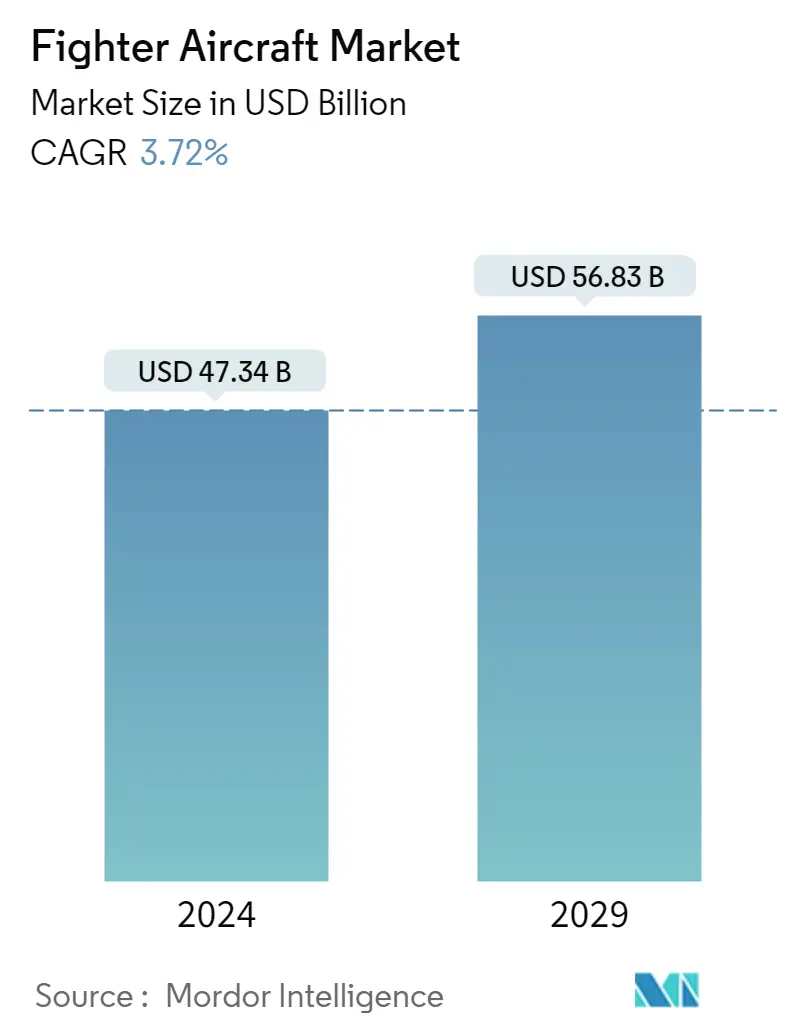Market Size of Fighter Aircraft Industry

| Study Period | 2020 - 2029 |
| Market Size (2024) | USD 47.34 Billion |
| Market Size (2029) | USD 56.83 Billion |
| CAGR (2024 - 2029) | 3.72 % |
| Fastest Growing Market | Asia Pacific |
| Largest Market | North America |
Major Players
*Disclaimer: Major Players sorted in no particular order |
Fighter Aircraft Market Analysis
The Fighter Aircraft Market size is estimated at USD 47.34 billion in 2024, and is expected to reach USD 56.83 billion by 2029, growing at a CAGR of 3.72% during the forecast period (2024-2029).
- The COVID-19 pandemic negatively impacted the fighter aircraft market, affecting delivery and production. Stringent regulations aimed at reducing the spread of the virus caused delays in the delivery of fighter aircraft to various countries. Furthermore, the pandemic led to layoffs in various companies, hampering the production process. However, with the decline in the pandemic, the market witnessed growth due to the ease in restrictions and increased production and delivery of fighter aircraft worldwide.
- The growing geopolitical tensions between nations have prompted the adoption of advanced fighter aircraft to modernize existing fleets and enhance their aerial defense capabilities. Advancements in technology, such as stealth and precision weapons, are further supporting the development of the fighter aircraft market as nations strive to keep their combat capabilities up-to-date.
- However, budget constraints may hinder market growth, particularly for developing countries that may opt for upgrading existing old fighters to cut costs rather than investing in next-generation fighter jets.
Fighter Aircraft Industry Segmentation
A fighter aircraft can be termed a high-speed fixed-wing military aircraft that can carry out air-to-air combat missions. High speed, ease of maneuvering, and relatively smaller size are the hallmarks of fighter aircraft. These aircraft can also carry heavy payloads and perform electronic warfare, ground attacks, and air-to-air combat.
The fighter aircraft market is segmented by take-off and landing, type, and geography. By take-off and landing, the market has been segmented into conventional take-off and landing, short take-off and landing, and vertical take-off and landing. By type, the market has been segmented into light attack, electronic warfare, multi-role fighter, trainers, and others. By geography, the market has been segmented into North America, Europe, Asia-Pacific, Latin America, and the Middle East and Africa.
The market sizes and forecasts are provided in terms of value (USD million) for all the above segments.
| Take-off and Landing | |
| Conventional Take-off and Landing | |
| Short Take-off and Landing | |
| Vertical Take-off and Landing |
| Type | |
| Light Attack | |
| Electronic Warfare | |
| Multi-Role Fighter | |
| Trainers | |
| Other Types |
| Geography | |||||||
| |||||||
| |||||||
| |||||||
| |||||||
|
Fighter Aircraft Market Size Summary
The fighter aircraft market is poised for growth over the forecast period, driven by increasing geopolitical tensions and the need for nations to modernize their aerial defense capabilities. The market experienced setbacks due to the COVID-19 pandemic, which caused production delays and workforce reductions. However, as restrictions eased, the market began to recover, supported by advancements in technology such as stealth and precision weapons. The demand for conventional take-off and landing aircraft is expected to rise, fueled by new fighter aircraft programs and modernization efforts in various countries. Despite budget constraints, particularly in developing nations, the push for upgrading aging fleets and procuring next-generation aircraft remains strong.
North America is anticipated to witness significant growth, with the United States leading in defense spending and actively addressing its aging aircraft fleet. The U.S. Department of Defense is committed to manufacturing a substantial number of F-35 fighter jets and modernizing its utility helicopter fleet. Key industry players like Lockheed Martin, Boeing, and Saab AB are at the forefront, with Lockheed Martin maintaining a dominant position through high delivery volumes and ongoing research and development. These developments, along with strategic acquisitions and partnerships, are expected to contribute to the robust growth of the fighter aircraft market during the forecast period.
Fighter Aircraft Market Size - Table of Contents
-
1. Market Dynamics
-
1.1 Market Overview
-
1.2 Market Drivers
-
1.3 Market Restraints
-
1.4 Industry Attractiveness - Porter's Five Forces Analysis
-
1.4.1 Threat of New Entrants
-
1.4.2 Bargaining Power of Buyers/Consumers
-
1.4.3 Bargaining Power of Suppliers
-
1.4.4 Threat of Substitute Products
-
1.4.5 Intensity of Competitive Rivalry
-
-
-
2. Market Segmentation
-
2.1 Take-off and Landing
-
2.1.1 Conventional Take-off and Landing
-
2.1.2 Short Take-off and Landing
-
2.1.3 Vertical Take-off and Landing
-
-
2.2 Type
-
2.2.1 Light Attack
-
2.2.2 Electronic Warfare
-
2.2.3 Multi-Role Fighter
-
2.2.4 Trainers
-
2.2.5 Other Types
-
-
2.3 Geography
-
2.3.1 North America
-
2.3.1.1 United States
-
2.3.1.2 Canada
-
-
2.3.2 Europe
-
2.3.2.1 Germany
-
2.3.2.2 United Kingdom
-
2.3.2.3 France
-
2.3.2.4 Russia
-
2.3.2.5 Rest of Europe
-
-
2.3.3 Asia-Pacific
-
2.3.3.1 China
-
2.3.3.2 India
-
2.3.3.3 Japan
-
2.3.3.4 South Korea
-
2.3.3.5 Rest of Asia-Pacific
-
-
2.3.4 Latin America
-
2.3.4.1 Brazil
-
2.3.4.2 Rest of Latin America
-
-
2.3.5 Middle East and Africa
-
2.3.5.1 United Arab Emirates
-
2.3.5.2 Saudi Arabia
-
2.3.5.3 Egypt
-
2.3.5.4 Rest of Middle East and Africa
-
-
-
Fighter Aircraft Market Size FAQs
How big is the Fighter Aircraft Market?
The Fighter Aircraft Market size is expected to reach USD 47.34 billion in 2024 and grow at a CAGR of 3.72% to reach USD 56.83 billion by 2029.
What is the current Fighter Aircraft Market size?
In 2024, the Fighter Aircraft Market size is expected to reach USD 47.34 billion.

